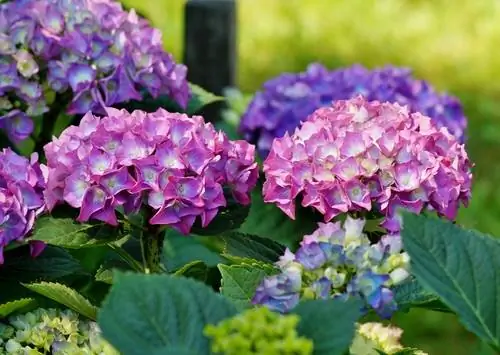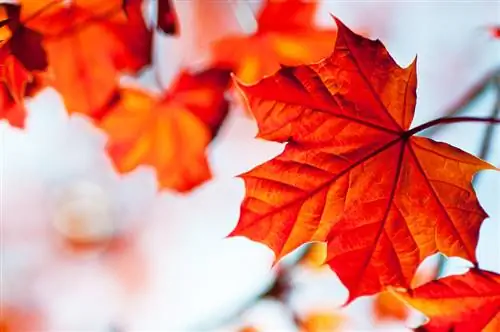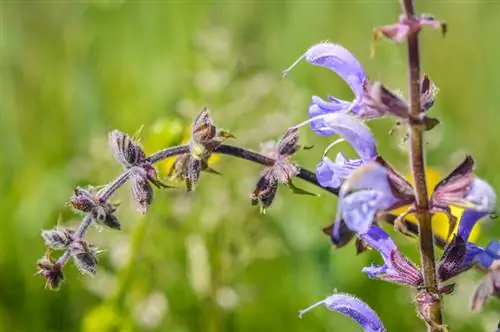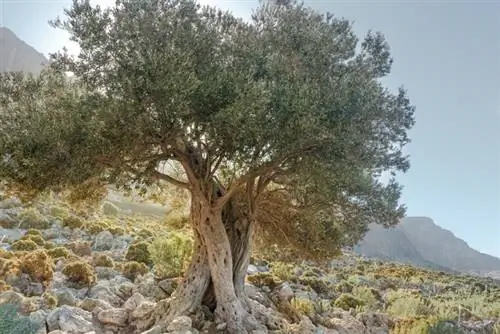- Author admin [email protected].
- Public 2023-12-16 16:46.
- Last modified 2025-01-23 11:21.
Under trees and in half-shaded corners, hydrangeas enchant with their romantic vintage charm. If they are in the right place, they are also surprisingly easy to care for. The main flowering period is in July and August, which is why we would like to introduce the hydrangea to you in more detail in today's newsletter.

What are the characteristics of hydrangeas?
Hydrangeas (Hydrangea) are woody sub-shrubs with a height of up to 2 meters. They bloom from June to September and delight with flowers in blue, red, pink, purple and white. Hydrangeas prefer partially shaded, wind-protected locations and nutrient-rich, humus-rich soils.
Plant profile:
- Botanical name: Hydrangea
- Order: Cornales
- Genus: Hydrangeas
- Family: Hydrangeaceae (hydrangea family)
- Growth: Woody subshrub.
- Growth height: Up to two meters. Climbing hydrangeas can even climb up to 15 meters in height, supported by a climbing aid
- Main flowering period: June to September
- Leaf: Simple, ovate serrated, opposite
- Flowers: Inflorescence in the form of a flat or spherical umbel (umbel)
- Flower shape: Small flowers form multi-flowered clusters
- Flower color: blue, red, pink, violet, white
- Fruits: capsule fruits. Fertile fruits are usually not to be expected from garden forms
Special features:
Flowering hydrangeas show an impressive play of colors: the flower balls change from their actual color to a dull green or rusty red, which gives the plant an extremely attractive, morbid charm.
Origin:
The flowering small shrubs originally come from Japan, where they have been cultivated in gardens for many centuries. The wild forms can be found in sparse forests and even inhabit altitudes of up to 3,400 meters.
Location and care:
The hydrangea is a specialist when it comes to location. They prefer a partially shaded or shady spot that should be protected from the wind. Oak-leaved hydrangea and panicle hydrangea are exceptions, as these varieties also feel comfortable in the sun.
Floor
Hydrangeas love nutritious, deep, humus-rich and loose soil. Contrary to what is often read, they do not necessarily have to be in an acidic substrate. The range in which the pH value should be depends on the flower color.
If you have a preference for blue flowers, you can promote the desired color by adding three grams of alum per liter to the irrigation water.
Water and fertilize:
Translated, the name Hydrangea means “water slurper”. He describes the enormous thirst that the hydrangea has. For this reason, it is important that the substrate retains moisture well.
Preferably water with soft, low-lime water from the rain barrel. Even though the soil should always be kept moist, do not overdo it, as waterlogging quickly leads to root rot.
Hydreneas are heavy feeders. Therefore, supply the plant with organic fertilizer or a special hydrangea fertilizer every two to three weeks until mid-summer.
Tip
Hydrangeas form magnificent flower umbels, but they can be too heavy for the stems. Give the small shrub additional support with plant supports or perennial holders so that the flowers do not break. Due to the dense foliage, the supports are hardly visible, so the appearance is not disturbed.






